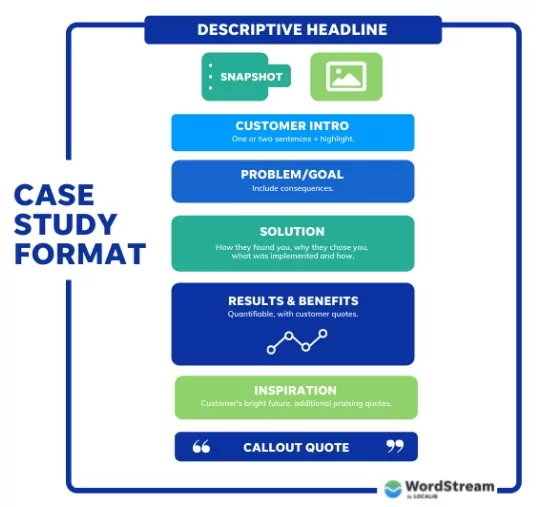Lead generation is an important part of your sales strategy. Converting those leads into sales, however, can be tricky. One important marketing tool your team can use to help nurture those leads is case studies. However, you need to know how to create case studies to use them effectively.
Case studies can be an effective way to give your business a more personal touch and let potential customers see how valuable your products and services can be. They function as a detailed customer review, and 92% of B2B customers are more inclined to purchase after reading trustworthy reviews.
Here, we will share the information you need to include in a case study and how to present it effectively.
Key Takeaways
- Case studies present a customer’s success story after using your products or services.
- Potential customers may feel more confident choosing your business after reading compelling case studies.
- Case studies should be concise, thorough, and tell a story using real data.
What Is a Case Study?
A case study is typically a document that outlines how a particular customer benefited from one or more of your products or services. It offers real-world proof to your leads that your business can help them solve a problem and is an important part of lead nurturing.
Most case studies focus on a customer’s specific challenge and how their chosen solution solved that problem. For example, a case study might focus on how much revenue a client-generated because of your products.
The goal of a case study is for the reader to visualize themselves or their business in the customer’s place and envision achieving their goals with your solutions.
Importance of Case Studies
Companies often overlook the importance of case studies. They can be a driving force in lead nurturing and be an important part of your content marketing strategy.
Case studies can:
- Assist with sales: Case studies are an asset sales staff can share with potential customers. They can help leads feel more confident if they choose you.
- Increase customer loyalty: Once a lead becomes a client, you don’t want them feeling buyer’s remorse. Case studies are a great way to offer social proof that your business is the right choice.
- Build trust: Most case studies include statistics and other tangible data that can help clients build trust in your brand. This data is proof of your value.
- Create multi-purpose content: Data and quotes from your case studies are ideal for repurposing in a testimonial section on your website, like the example below. You can also turn your case studies into blog posts, infographics, PDFs, and videos.
Source: mxtrautomation
Elements of an Effective Case Study
A case study shares evidence of a customer’s success using your business. This evidence usually comes in the form of data and quotes. Unfortunately, a lot of case studies come off as boring because the evidence is not presented with a compelling story.
Many case studies follow a specific format, like the one presented below.
Source: wordstream
If you want to create an effective case study that your leads enjoy reading, your case studies need the following three elements.
- Case Studies Should Be Concise
While there is no rule on the length of a case study, it should be as short as you can make it. Stick to the main and most compelling elements while avoiding the minutiae. This will keep it concise and to the point.
- Case Studies Should Be Thorough
In addition to being concise, case studies should be thorough. If you make a claim that your product helped a customer, you have to tell how they achieved those results. Your case study should include key details that show how the customer went from point A to point B using your services. If you have any applicable videos or images that help share these details, include them.
- Case Studies Should Tell a Story
The most important aspect of a case study is how well it tells a story. It should have a clear beginning, middle, and end that compels the reader to keep reading. Case studies that highlight the tension caused by the customer’s problem and how they solved it will be the most engaging.
How to Create a Case Study
When you decide to create a case study, focus on your best customers. Once you have narrowed down your options, ask them if they would be interested in being the focus of a case study. From there, you will ask questions, collect data, and get quotes.
Now, you are ready to create a case study.
- Make the Customer the Hero of the Story
A case study is really about your customer and not about you. Start the case study by introducing them and offering some background information, like the company size, industry, and location.
- Explain the Problem
You design your products and services to solve a problem. Explain what problem your customer had that your business helped them solve. Emphasize the impact of the problem and how high the stakes were. For example, maybe they were losing customers and revenue and without a solution, their business might fail.
- Introduce the Solution
In this section, you will briefly introduce the product or service that solved the problem. Make sure you clearly show how your product helped the company and how they used it.
- Highlight the Results
The results are the most important part of a case study. Potential customers want to see the real impact of your products. Use data and numbers as much as you can to prove the results. This type of information will be the most compelling for readers.
- Lay Out a Path
Make sure you show proof of how the customer achieved these results using your products. Outline the steps they took. This will make it easier for potential customers to envision themselves taking the same steps to get similar results.
This video offers more information on how you can use case studies to attract more customers.
Optimize Your Lead Nurturing Strategy with MXTR
Case studies are just a small part of an overall lead nurturing strategy. At MXTR, we support your lead strategy with automated nurturing and marketing. Our solutions automatically send leads to the right team and let your business monitor your leads’ information wherever you are for stronger results.
Ready to see how MXTR can help you improve your lead nurturing strategy? Schedule a demo today.
Featured Image: istockphoto









